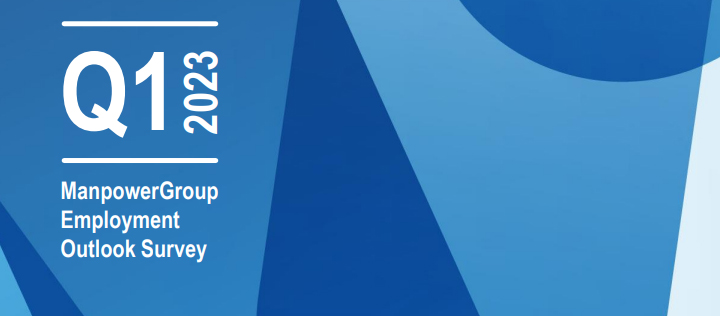COMMUNICATIONS & FINANCE SECTORS BOOM;
I.T SECTOR PUTS ON THE BRAKES IN Q1 2023
Ireland’s Net Employment Outlook remains a positive +23%, a slight decline of 3 percentage-points on Q4 2022
Dublin-based Communications Services and Finance sectors lead the pack with hiring intentions of +46% and +43%
However, the I.T sector puts on the brakes but remains positive with +9% intending to hire
Big businesses hiring cools, but small businesses expand hiring plans with +41% intending to hire.
Irish employers will enter a state of cautious growth in the new year, according to the latest ManpowerGroup Employment Outlook Survey. In the first quarter of 2023 the national hiring Outlook is +25%, down 3 percentage-points on last quarter and down 22 percentage-points on Q1 2022’s record start to a year. All sectors remain positive, but employers paint a mixed picture – with hiring surging in the Dublin-based Finance sectors, but employers in the Tech, Hospitality & Consumer goods sectors are less optimistic.
Download the full Q1 2023 ManpowerGroup Ireland Employment Outlook Report Here
The ManpowerGroup Employment Outlook Survey is based on responses from 410 employers across Ireland. It asks whether employers intend to hire additional workers or reduce the size of their workforce in the coming quarter. It is the most comprehensive, forward-looking employment survey of its kind in the world.
The Communication Services sector is recording the strongest hiring intention in Ireland, with +46% of employers in the telecommunications, entertainment and media space planning to hire in the first quarter, an increase of 28 percentage-points on last quarter and up + percentage-points year-on-year. This is followed by the Finance & Real Estate sector, with +43% of employers plan to hire, an increase of 9 percentage-points on last quarter and up 13 percentage points year-on-year. “All sectors remain optimistic, but it’s a mixed picture.” said John Galvin, Managing Director, ManpowerGroup Ireland. “We’re seeing the communications industry go from strength to strength, and the Finance sector continues to boom – both showing record hiring intentions. However, the previously booming Tech sector is now much more cautious following a period of unprecedented hiring, impacted by lay-offs in big-tech companies based in Dublin.
Employers in Dublin report a hiring Outlook of +27%, an increase of 4 percentage-points on last quarter and a decline of -20 percentage-points year-on-year. Ulster is the most optimistic region at (+29%) in bucking the national trend by increasing hiring intention in Q1. Munster (+16%), Leinster (+20%), and Connaught (+23%) report positive Outlooks. “Dublin is continuing to perform as a global centre of business activity.” explains Galvin. “Despite a slight national decline and hit to the tech sector, Dublin remains buoyant – driven by the City’s booming Finance industry which continues to see the benefits of international investment, and a burgeoning Life Sciences sector which has accelerated hiring since last quarter.”
The Consumer Goods & Services sector is recording a hiring intention of +12%, down 10 percentage-points on last quarter and a decline of 43 percentage-points year-on-year. This indicates a slowdown in hiring across restaurants, hotels, arts, and retail trade, particularly outside of major metropolitan areas. Galvin explains: “As economic pressures put a squeeze on all of us, we’re seeing employers across the service sector rein in their hiring plans, particularly in rural parts of the country where businesses are less insulated from economic shocks. However, the mood leans towards cautious growth as employers are still hiring in positive numbers.”
Much of the decline in Outlook has been driven by larger employers, with 21% intending to hire in Q1, a decline of -25 percentage-points on last quarter. Meanwhile, 41% of businesses with ten employees or less intend to hire, up 12 percentage-points on last quarter and up 7 percentage-points on last year. “As large organisations took the lead in the majority of hiring for most of 2022, we are seeing smaller business become more confident in their growth prospects. We are also seeing cases where smaller businesses are taking advantage of larger organisations restructuring programs and snapping up staff they were previously unable to attract due to competition with large organisations” Galvin concludes.









